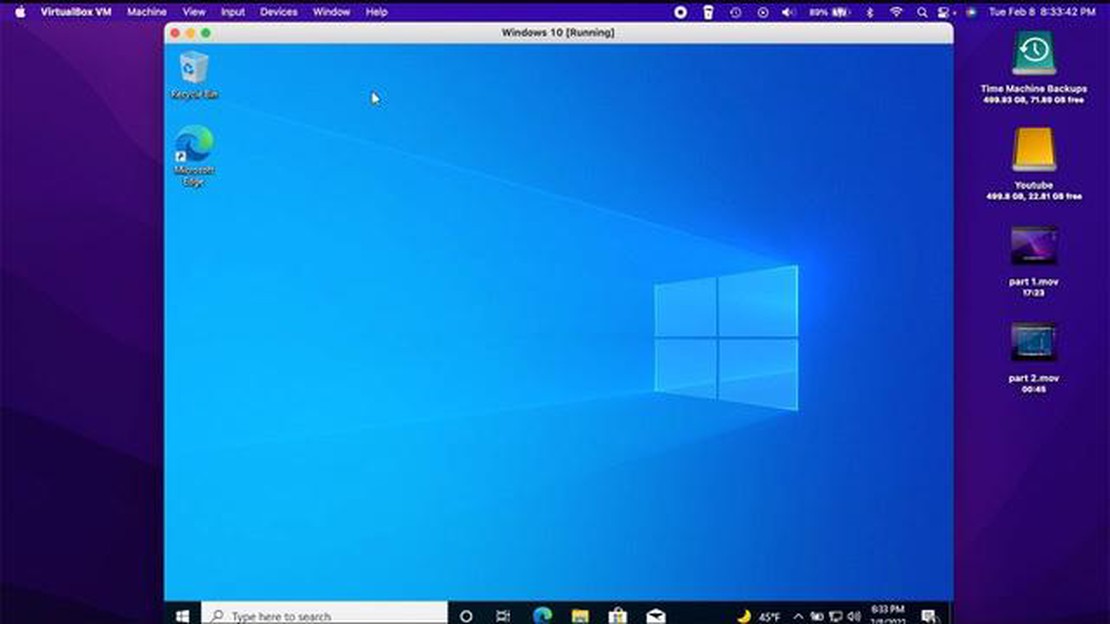Quick Fix for Diablo 3 Locking and Crashing Issues
Diablo 3 Locking and Crashing Quick Fix If you’re a fan of the action role-playing game Diablo 3 and have experienced frequent locking and crashing …
Read Article
Many Mac owners often find themselves using the Windows operating system. Whether it’s to work with programs that are only available for Windows, or to test websites in different browsers. VirtualBox is free software that allows you to run virtual machines with a variety of operating systems, including Windows 10. In this step-by-step instruction, we will show you how to run Windows 10 on Mac using VirtualBox.
The first step is to download and install VirtualBox on your Mac. You can download it from the official VirtualBox website. After installing VirtualBox, you will also need a Windows 10 installation image. You can download it from Microsoft’s official website. Make sure you choose the right version of Windows 10 for your Mac.
After installing VirtualBox, open it and click on the “New” button to create a new virtual machine. Set the name and type of operating system (Windows 10) for your virtual machine. Make sure you choose the 64-bit Windows 10 version if your Mac supports it.
While configuring the virtual machine, you have to specify several parameters such as the amount of RAM, number of processors, and the size of the virtual hard disk. You can customize these settings according to your needs, but make sure you allocate enough resources to run Windows 10 smoothly on your Mac.
After setting up the virtual machine, select the Windows 10 ISO image file you downloaded earlier as the boot option. Start the virtual machine and follow the instructions of the Windows 10 installer to install the operating system on the virtual hard disk. Once the Windows 10 installation is complete, enjoy running the operating system on your Mac using VirtualBox!
While running Windows 10 on your Mac using VirtualBox may take some time and require some of your computer’s resources, it’s a great way to utilize both operating systems on the same device. Virtual machines also allow you to experiment with different versions of Windows and other operating systems without having to create separate partitions on your hard drive. Use these step-by-step instructions and enjoy Windows 10 on your Mac!
Before you can run Windows 10 on your Mac using VirtualBox, there are a few preparatory steps you need to take.
After completing these steps, you’ll be ready to install Windows 10 on your Mac using VirtualBox.
To run Windows 10 on Mac using VirtualBox, you’ll need to first install the VirtualBox program itself on your computer. Here are step-by-step instructions for installing VirtualBox on your Mac:
Read Also: Easy Ways to Test Android Internet Speed - Step-by-Step Guide
Congratulations!!! You now have VirtualBox installed on your Mac, and you’re ready to start creating a virtual machine to run Windows 10.
To install Windows 10 on your Mac using VirtualBox, you need to download a Windows 10 operating system image. The instructions are as follows:
Congratulations! You now have a Windows 10 operating system image that you can use to install on your Mac using VirtualBox.
To run Windows 10 on a Mac using VirtualBox, you need to create a new virtual machine. This section will describe how to perform this operation.
Congratulations!!! You now have a Windows 10 virtual machine on your Mac using VirtualBox.
Before you can run Windows 10 on your Mac using VirtualBox, you’ll need to create a new virtual machine. Follow these steps:
Read Also: Facebook Timeline Not Updating on Galaxy S22: Step-by-Step Guide | [Website]
Congratulations! You’ve just created a new virtual machine in VirtualBox. Now you’re ready to install Windows 10 on your Mac.
After installing VirtualBox on your Mac, you need to configure your virtual machine settings before you can run Windows 10 on it. Here are the step-by-step instructions:
Once these settings are complete, you will see the virtual machine (Windows 10) in the list of virtual machines in the VirtualBox program. Now you are ready to move on to the next step - installing Windows 10 on the virtual machine.
To run a Windows 10 Virtual Machine on a Mac using VirtualBox, you will need a macOS operating system.
You can download VirtualBox for Mac from the official VirtualBox website: https://www.virtualbox.org .
The minimum system requirements to run Windows 10 via VirtualBox on a Mac include the following: an Intel or AMD processor with virtualization support, 4GB of RAM, enough free hard drive space for installation, and Windows 10 image sizes.
Yes, you can use programs other than VirtualBox to run Windows 10 on a Mac, such as Parallels Desktop and VMWare Fusion. Each of them has different features and functionality, so choosing a program depends on your preferences and requirements.
Diablo 3 Locking and Crashing Quick Fix If you’re a fan of the action role-playing game Diablo 3 and have experienced frequent locking and crashing …
Read ArticleHow To Fix Sony TV Won’t Connect To Wifi Issue Having trouble connecting your Sony TV to wifi? Don’t worry, you’re not alone. Many Sony TV owners have …
Read Article10 best augmented reality apps for android Augmented reality (AR) is a technology that allows us to add virtual objects and information to the real …
Read ArticleHow To Fix Windows Script Host Error If you’re encountering the Windows Script Host Error on your computer, don’t worry, you’re not alone. This error …
Read ArticleHow to fix Samsung Galaxy S6 that keeps freezing & restarting after Android 6.0.1 Marshmallow update If you own a Samsung Galaxy S6 and recently …
Read Articlexbox live gold members get access to ninja gaiden 3. Our friends on the Xbox Live team have happily announced a new addition to their library of games …
Read Article